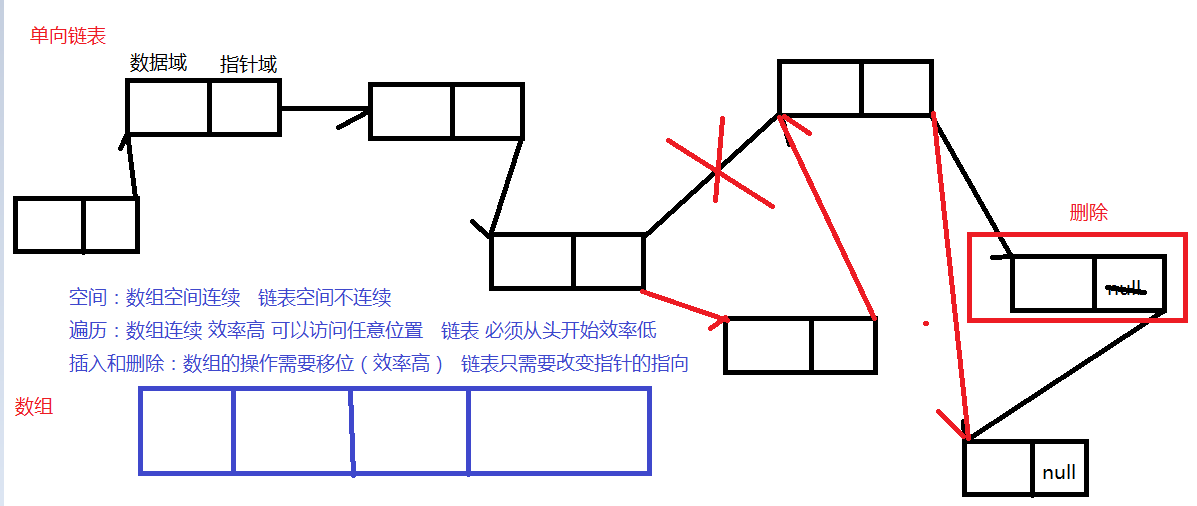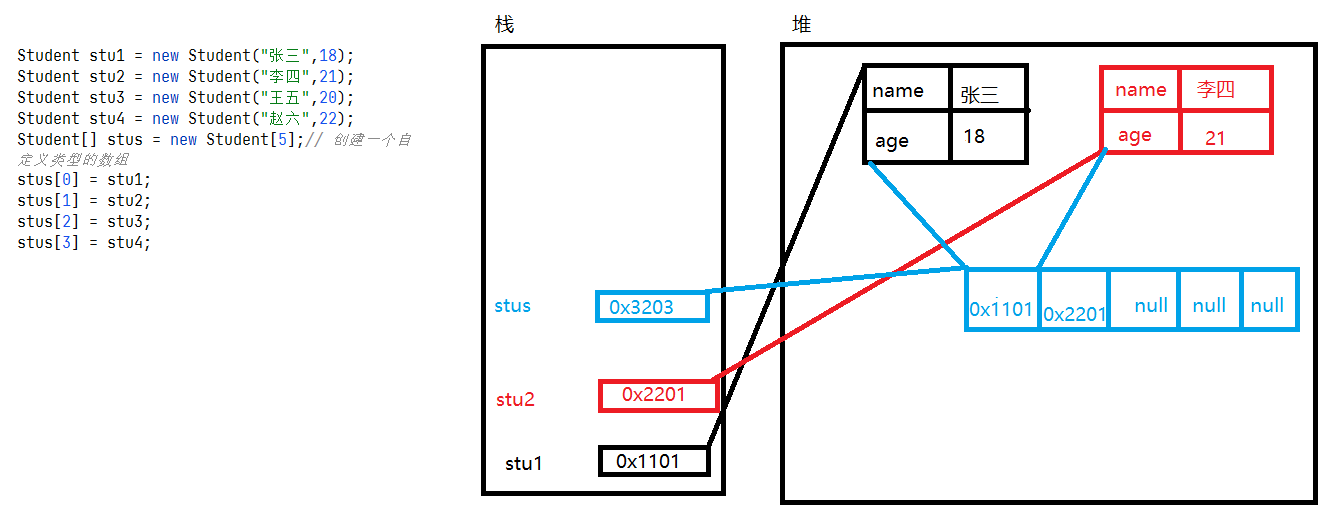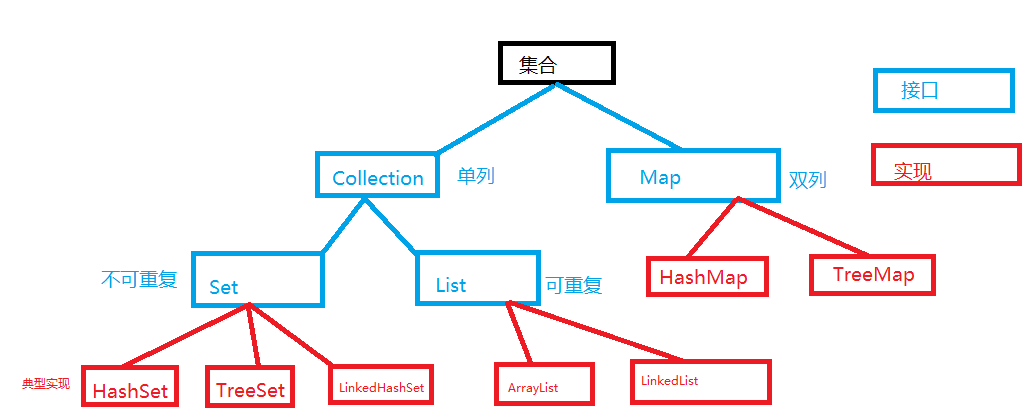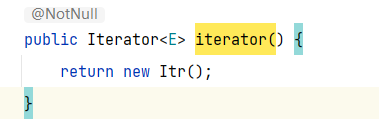1. Linked list
A linked list is usually composed of a series of nodes. Each node contains any instance data and one or two links to the location of the previous or next node.
Linked list is a linear list, but it does not store data in linear order, but stores the pointer of the next node in each node.
1.1 classification
The node of a single linked list is divided into two parts. The first part saves the data of the node and the second part saves the address of the next node. The portion of the last node's storage address points to a null value.
Unidirectional linked list can only traverse in one direction. When finding a node, you need to start from one node and visit the next node every time until the required location

public class SingleLinkedList {
// Number of nodes in the linked list
private int size;
//Head node
private Node head;
public SingleLinkedList(){
size = 0;a
head= null;
}
// Node class of linked list
private class Node{
private Object data;//Data field of node
private Node next;//Pointer to the next node
public Node(Object data){
this.data = data;
}
}
// Add elements C - > b - > A to the linked list
public Object addHead(Object data){
Node newHead = new Node(data);// Create a new node
if(size == 0 ){
head = newHead;
}else{
newHead.next = head;//The pointer of the new node points to the original header node
head = newHead;//The head node points to the new node
}
size++;
return data;
}
// Delete node does not delete the node in the chain header
public Object deleteHead(){
Object obj = head.data;
head = head.next;
size--;
return obj;
}
//Find the specified element in the linked list, find the return Node node, and return null if it is not found
public Node find(Object data){
Node current = head;//Define a pointer to the node of the current comparison
int tempSize = size;// Gets the number of elements in the current linked list
while(tempSize > 0 ){
if(data.equals(current.data)){
return current;
}else{
current = current.next;
}
tempSize--;
}
return null;
}
// If the specified element is deleted successfully, return true; otherwise, return false
public boolean delete(Object data){
if(size == 0 ){
return false;
}
// Get the previous node and its subsequent node of the deleted node
Node current = head;
Node previous = head;
while(!current.data.equals(data)){
if (current.next == null){// Judge whether to reach the end of the linked list
return false;
}else{// The current node is not the node we want to delete and does not reach the end of the node
previous = current;//Moves the pointer of the previous node
current = current.next;//Move the pointer of the current node to the next node
}
}
// This indicates that the node to be deleted has been found. Judge whether the deleted node is the head node
if(current == head){
head = current.next;
size--;
}else{//Not a header node
previous.next =current.next;
size--;
}
return true;
}
// Judge whether the node is empty
public boolean isEmpty(){
return size==0;
}
// Traversal linked list
public void display(){
if(size > 0 ){
Node node = head;
int tempSize = size;
if(tempSize == 1){// If the current linked list has only one header node
System.out.println("[" + node.data+"]");
return;
}
while(tempSize >0 ){
if(node.equals(head)){
System.out.print("[" + node.data+"->");
}else if(node.next == null){
System.out.print( node.data+"]");
}else{
System.out.print(node.data+"->");
}
node= node.next;
tempSize--;
}
System.out.println();
}else{// The linked list has no nodes
System.out.println("[]");
}
}
}
test
public class SingleLinkListTest {
public static void main(String[] args) {
SingleLinkedList sls = new SingleLinkedList();
sls.addHead("A");
sls.addHead("B");
sls.addHead("C");
sls.addHead("D");
sls.display();
//Test delete element delete C
sls.delete("C");
sls.display();
//Find B
System.out.println(sls.find("C"));
}
}
1.2 differences between stack queue linked lists
The stack queue is a linear table with limited operation.
The difference is that the operation rules are different
Linked lists and arrays:
1 occupied memory space the memory space stored in the linked list can be continuous or discontinuous. The array must be continuous.
2 length variability the length of the linked list can be customized according to actual needs. Once the array length is defined, it cannot be changed.
3. Data access: linked list access requires mobile access, which is more convenient than array access
4 usage scenario: the element array is more suitable for large amount of data and frequent access
Delete, insert and other operations are more suitable for linked lists
Features of linked list:
Logical structure one to one
Storage result sequence table chain table
Operation rules: stored in random order
Stack:
Logical structure one to one
Store result sequence stack
Operation rules: last in, first out, first in, last out
queue
Logical structure one to one
Storage result sequence queue
Operation rules: first in first out
Bidirectional linked list

Circular linked list:

2. Nonlinear structure (tree structure)
2.1 binary tree

Each element is called a node
A root node
B C D parent node
Leaf node: node without child nodes (H E F G)
Height of tree: maximum number of layers
subtree
The forest is made up of several sub trees
A tree in which each node has at most two child nodes is called a binary tree
If the leaf nodes of all binary trees are at the last time. The number of nodes = 2^n - 1 n is the number of layers. Such a binary tree is called a full binary tree
2.2 traversal of binary tree
Preorder traversal: first output the parent node, and then traverse the left and right subtrees
Medium order traversal: first traverse the left subtree, then the output parent node, and finally traverse the right subtree
Post order traversal: first traverse the left subtree, then the right subtree, and finally output the parent node
Sequence traversal: traverse layer by layer according to the level

2.3 red black tree
Red black tree is a kind of binary tree with red black nodes and can be self balanced. He must satisfy the following properties:
1 each node is either black or red
2. The root node is black
3 each leaf node is NIL and black
4 the two child nodes of each red node must be black
The path from any node to the leaf node contains the same number of black nodes

3 set
public class Student {
private String name;
private int age;
public Student() {
}
public Student(String name, int age) {
this.name = name;
this.age = age;
}
public String getName() {
return name;
}
public void setName(String name) {
this.name = name;
}
public int getAge() {
return age;
}
public void setAge(int age) {
this.age = age;
}
@Override
public String toString() {
return "Student{" +
"name='" + name + '\'' +
", age=" + age +
'}';
}
}
public class StudentTest {
public static void main(String[] args) {
Student stu1 = new Student("Zhang San",18);
Student stu2 = new Student("Li Si",21);
Student stu3 = new Student("Wang Wu",20);
Student stu4 = new Student("Zhao Liu",22);
Student[] stus = new Student[5];// Create an array of custom types
stus[0] = stu1;
stus[1] = stu2;
stus[2] = stu3;
stus[3] = stu4;
for(Student student :stus){
System.out.println(student);
}
}
}
In the above code, the array is used to store multiple objects, but the array itself has some inevitable disadvantages. java provides a new structure for storing objects. This structure is a collection. The collection is like a container, which can dynamically put the references of multiple objects into the container.

Characteristics of array in memory storage:
1 the length of the array is determined after initialization and cannot be changed
2 the type of array declaration determines the type of element initialization
Disadvantages of array in storage:
1. After the output is initialized, the length is not variable and it is not easy to expand
2 there are few attributes and methods provided in the array, which is not convenient for adding, deleting, inserting and other operations on elements, and the efficiency is not high. At the same time, the number of stored elements cannot be obtained directly.
3 the data stored in the array is orderly and can be repeated.
java collections can store multiple objects in varying numbers, and can also store data with mapping relationships.
3.1 architecture of collection
Collection features: provide a storage model with variable storage space, and the capacity of stored data can be changed at any time.
-
public interface Collection<E> extends Iterable<E>
The root interface in the collection hierarchy can only store objects, but other collections are not allowed. Some sets are ordered, while others are disordered. The JDK does not provide any direct implementation of this interface: it provides more specific implementations of sub interfaces, such as Set and List. This interface is typically used to pass collections and operate on them when maximum versatility is required. (polymorphism)

3.2 use of collection interface
Collection is the top-level interface of a single column collection. It represents a set of objects, which are also called elements.
The JDK does not provide a direct implementation of this interface, but you can create collection objects through the implementation of sub interfaces
-
-
boolean Add (E) ensures that the collection contains the specified element (optional operation). boolean Addall (collection <? Extensions E > C) adds all elements in the specified collection to this collection (optional). void clear() removes all elements from this collection (optional). boolean contains(Object o) returns true if the collection contains the specified element. boolean Containsall (collection <? > C) returns true if the collection contains all elements in the specified collection. boolean equals(Object o) compares the specified object to this collection for equality. int hashCode() returns the hash code value of this collection. boolean isEmpty() returns true if this collection does not contain elements. Iterator<E> iterator() returns an iterator for the elements in this collection. boolean remove(Object o) removes a single instance (if any) of the specified element from the collection (optional). boolean RemoveAll (collection <? > C) deletes all elements of this collection contained in the specified collection (optional). boolean Retain all (collection <? > C) only the elements contained in the specified collection in this collection are retained (optional operation). int size() returns the number of elements in this collection. Object[] toArray() returns an array containing all the elements in this collection. <T> T[] toArray(T[] a) returns an array containing all elements in this collection; The runtime type of the returned array is the runtime type of the specified array.
-
public static void main(String[] args) {
//Create a Collection object
Collection collection = new ArrayList();
//Adding elements to methods in the Collection interface
collection.add("Hello");
collection.add(123);//Packing class of basic type corresponding to automatic packing
collection.add(true);
System.out.println(collection);
}
public static void main(String[] args) {
//Create a Collection object
Collection collection = new ArrayList();
//Adding elements to methods in the Collection interface
collection.add("Hello");
collection.add(123);//Packing class of basic type corresponding to automatic packing
collection.add(true);
// collection.clear();// Clear elements in collection
// Determine whether the collection contains an object
System.out.println(collection.contains(123));
// Remove an element from the collection
System.out.println(collection.remove(123));
// Determine whether the collection is empty
System.out.println(collection.isEmpty());
//Gets the number of elements in the collection
System.out.println(collection.size());
//Convert a collection to an array
Object[] arr = collection.toArray();
System.out.println(arr.length);
System.out.println(collection);
}
public class CollectionTest { public static void main(String[] args) { //Create a collection object collection collection = new arraylist()// Add the element collection. Add ("hello") to the method in the collection interface; collection.add(123);// The packing class collection.add (true) of the basic type corresponding to automatic packing; Collection c1 = new ArrayList(); c1.add("world"); c1.add("hello"); c1.add(false); Student stu1 = new student ("Zhang San", 18); c1.add(stu1); // addAll collection.addAll(c1); System.out.println(collection); // Judge whether the set contains all elements in another set, System.out.println(collection.containsAll(c1))// Take the intersection of two sets and store it in the current collection. RetainAll (C1); System.out.println(collection); // Delete another collection in this collection / / collection.removeall (C1)// System.out.println(collection); }
3.2.1. Iterator
Iterator for iterated sets
-
-
boolean hasNext() returns true if the iteration has more elements. E next() returns the next element in the iteration.
-
public static void main(String[] args) { //Create a Collection object Collection collection = new arraylist()// Add the element Collection. Add ("hello") to the method in the Collection interface; Collection.add(123);// The packing class Collection.add (true) of the basic type corresponding to automatic packing; Collection.add("world"); Collection.add("hello"); Collection.add(false); Student stu1 = new student ("Zhang San", 18); Collection.add(stu1); // Iterator iterator = Collection. Iterator()// Iterator is used to iterate the Collection while (ITER. Hasnext()) {object obj = ITER. Next(); system. Out. Println (obj);}}
Source code analysis
ArrayList

public boolean hasNext() { return cursor != size;// Size indicates the number of elements in the collection} @ suppresswarnings ("unchecked") public e next() {checkforconfirmation(); int i = cursor; if (I > = size) throw new nosuchelementexception(); object [] elementdata = arraylist.this.elementdata; if (I > = elementdata. Length) throw new ConcurrentModificationException(); cursor = i + 1; return (E) elementData[lastRet = i]; }
3.3 List
3.3.1 characteristics of list set
-
Ordered sets (also known as sequences). You can precisely control the insertion position of each element in the list. Users can access elements through integer indexes (positions in the list) and search for elements in the list.
-
Lists usually allow duplicate elements
-
null can be stored and multiple can be stored
Typical implementation
ArrayList LinkedList Vector
3.3.2 List interface specific methods
-
- add(int index, Object element) inserts the specified element into the specified position in this list (optional operation).
-
-
Object get(int index) returns the element at the specified position in this list.
-
-
-
int indexOf(Object o) returns the index of the first occurrence of the specified element in the list. If the list does not contain an element, it returns - 1.
-
-
-
-
int lastIndexOf(Object o) returns the index of the last occurrence of the specified element in the list. If the list does not contain an element, it returns - 1.
-
-
-
ListIterator<E> listIterator() returns the list iterators in the list (in the appropriate order).
-
-
-
E set(int index, E element) replaces the element at the specified position in this list with the specified element (optional operation).
-
-
-
List<E> subList(int fromIndex, int toIndex) returns the view between fromIndex (inclusive) and toIndex specified in this list.
-
3.3.3. Use of list
public class ListTest { public static void main(String[] args) { Student stu1 = new Student("Zhang San",18); Student stu2 = new Student("Li Si",21); Student stu3 = new Student("Wang Wu",20); Student stu4 = new Student("Zhao Liu",22); List list = new ArrayList(); list.add(stu4); list.add(stu3); list.add(stu2); list.add(stu1); list.add(stu1); list.add(stu2); list.add(stu3); list.add(stu4); Iterator iter = list.iterator(); while(iter.hasNext()){ Object obj = iter.next(); System.out.println(obj); } System.out.println("------------------------------"); for(int i = 0 ; i < list.size();i++){ Object obj = list.get(i); System.out.println(obj); } }}
Order of List set: the order here means that the storage order of elements is consistent with the iterative order
Iterative method of set
public static void main(String[] args) { Student stu1 = new Student("Zhang San",18); Student stu2 = new Student("Li Si",21); Student stu3 = new Student("Wang Wu",20); Student stu4 = new Student("Zhao Liu",22); List list = new ArrayList(); list.add(stu4); list.add(stu3); list.add(stu2); list.add(stu1); list.add(stu1); list.add(stu2); list.add(stu3); list.add(stu4); Iterator iter = list.iterator(); while(iter.hasNext()){ Object obj = iter.next(); System.out.println(obj); } System.out.println("------------------------------"); for(int i = 0 ; i < list.size();i++){ Object obj = list.get(i); System.out.println(obj); } System.out.println("------------------------------"); for(Object obj : list){ System.out.println(obj); } System.out.println("------------------------------"); for( Iterator itr = list.iterator();itr.hasNext();){ Object obj = itr.next();//When iterating with iterators, the next method can only call System.out.println(obj) at one place in a loop;} System.out.println("------------------------------"); Iterator itr1 = list.iterator(); For (; itr1. Hasnext();) {object obj = itr1. Next(); / / when iterating with iterators, the next method can only call System.out.println(obj);}}
Iterators use while and for, which is better:
The for loop is more conducive to the release of space
However, while is widely used in development
3.3.4 concurrent modification exception
public static void main(String[] args) { List list = new ArrayList(); list.add("hello"); list.add("world"); list.add("java"); Iterator iter = list.iterator(); while(iter.hasNext()){ Object obj = iter.next(); String str = (String) obj; if(str.equals("world")){ list.add("hadoop"); } } }

Concurrent modificationexception: concurrent modification exception
Causes:
In the process of iterating the set, the iterator modifies the elements of the set through the set object, resulting in the inconsistency between the expected modified value and the actual modified value judged by the iterator in the acquisition garden
Solution: traverse the set through the set itself, and modify the set itself
for(int i = 0 ; i < list.size();i++){ String str = (String)list.get(i); if(str.equals("world")){ // list.add("hadoop");// Add to the end of the set list.set(i,"hadoop")// Modify the element}} System.out.println(list);
3.3.5 ListIteator
-
-
void Add (E) inserts the specified element into the list (optional). boolean hasNext() returns true. If you traverse the forward list, the list iterator has multiple elements. boolean hasPrevious() returns true. If you traverse the reverse list, the list iterator has multiple elements. E next() returns the next element in the list and advances the cursor position. int nextIndex() returns the subsequent call. next() The index of the element returned. E previous() returns the previous element in the list and moves the cursor position backward. int previousIndex() is returned by subsequent calls previous() The index of the element returned. void remove() removes from the list next() or previous() The last element returned (optional operation). void For set (E) designated Element replacement by next() or previous() The last element returned (optional operation).
-
public class ListDemo { public static void main(String[] args) { List list = new ArrayList(); list.add("hello"); list.add("world"); list.add("java"); // Get list iterator listiterator = list. Listiterator()// While traversing Tianjian while (iterator. Hasnext()) {object obj = iterator. Next(); / / when the element is world, add the element spring if (obj. Equals ("world")) {iterator. Add ("spring"); iterator. Previous(); / / Yes, the pointer points to the previous element} System.out.println(obj); } System.out.println(list); System.out.println("-----------------------"); // Delete the element listiterator while iterating. Iterator1 = list. Listiterator(); while(iterator1.hasNext()){ Object obj = iterator1.next(); if(obj.equals("world")){ iterator1.remove(); }else{ System.out.println(obj); } } System.out.println("-----------------------"); // Modify listiterator iterator2 = list. Listiterator(); while(iterator2.hasNext()){ Object obj = iterator2.next(); if(obj.equals("hello")){ iterator2.set("mybatis"); iterator2.previous(); }else{ System.out.println(obj); } } }}
public static void main(String[] args) { List list = new ArrayList(); list.add("hello"); list.add("world"); list.add("java"); ListIterator iter = list.listIterator(); while(iter.hasNext()){ Object obj = iter.next(); System.out.println(obj); } System.out.println("----------------------");//Before reverse order, you must traverse while (ITER. Hasprevious()) {object obj = ITER. Previous(); system. Out. Println (obj);}}
List sub = list.subList(1,2);//The obtained subset contains 1 and does not contain 2 system.out.println (sub);